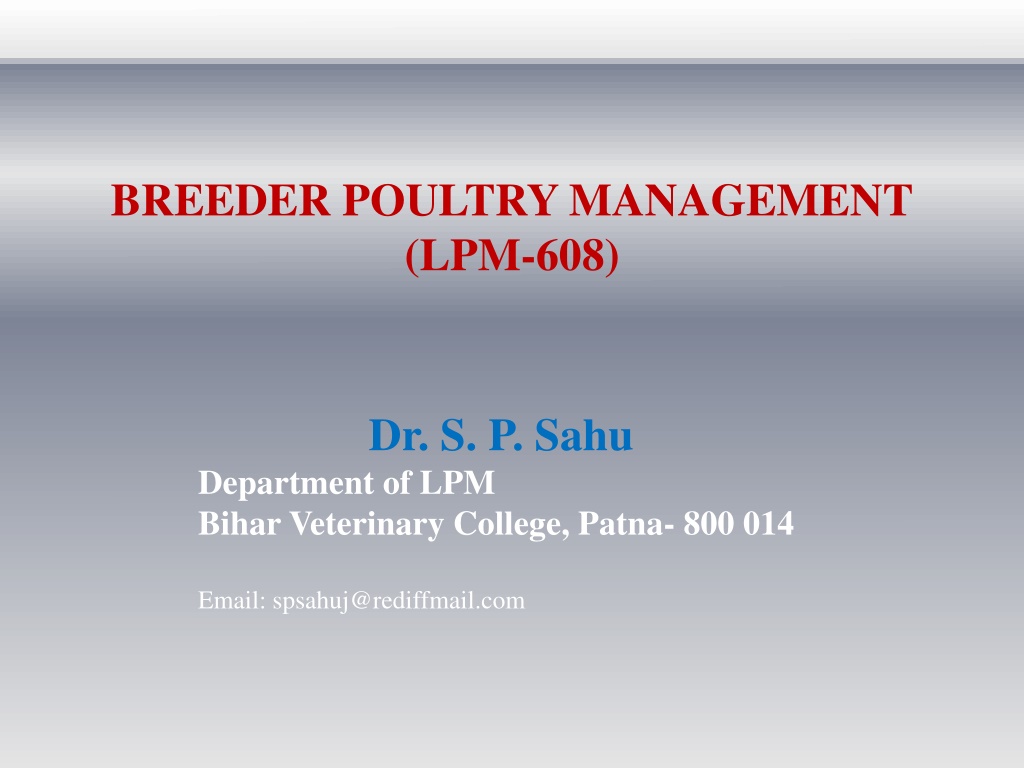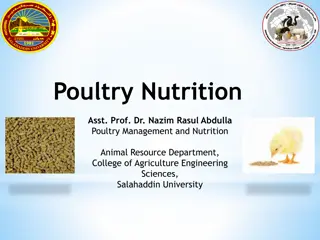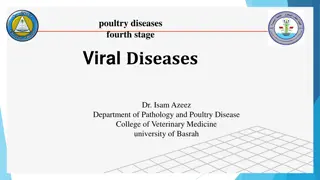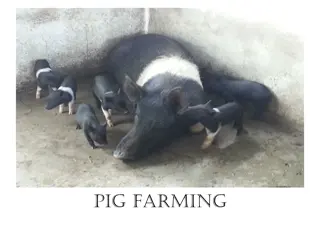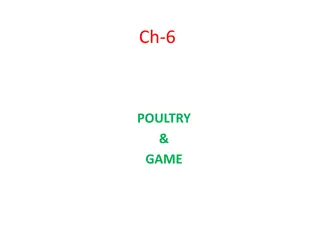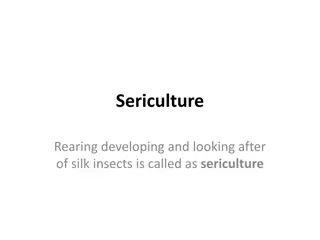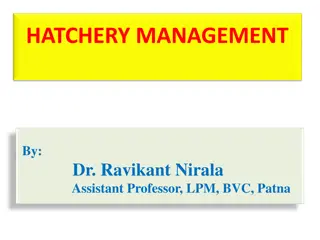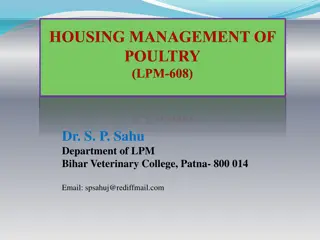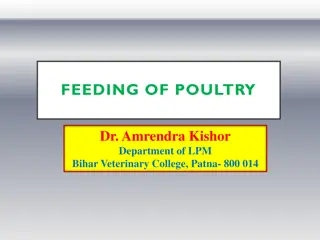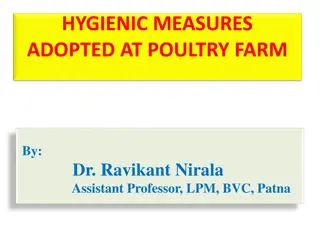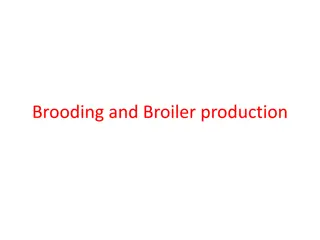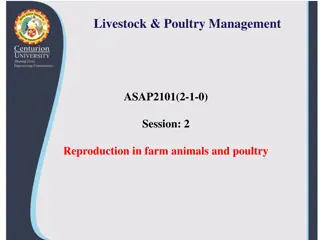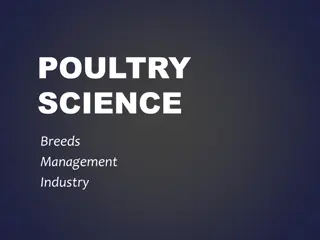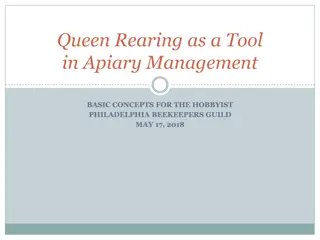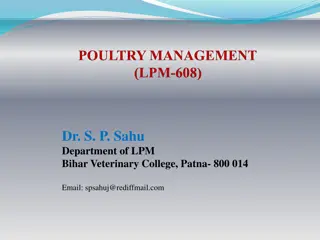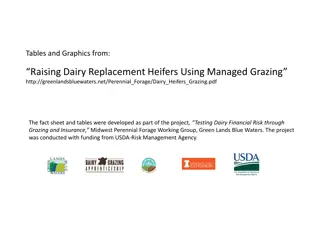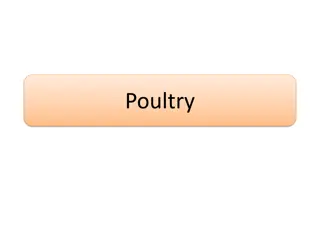Effective Breeder Poultry Management Tips for Successful Rearing
Key aspects of breeder poultry management including preparing for chicks arrival, rearing facilities maintenance, planning for chicks replacement, and floor space requirements. Emphasis on proper biosecurity measures, clean facilities, and adequate space for optimal growth. Tips provided for successful rearing and maximizing productivity in poultry farming.
Download Presentation

Please find below an Image/Link to download the presentation.
The content on the website is provided AS IS for your information and personal use only. It may not be sold, licensed, or shared on other websites without obtaining consent from the author. Download presentation by click this link. If you encounter any issues during the download, it is possible that the publisher has removed the file from their server.
E N D
Presentation Transcript
BREEDER POULTRY MANAGEMENT (LPM-608) Dr. S. P. Sahu Department of LPM Bihar Veterinary College, Patna- 800 014 Email: spsahuj@rediffmail.com
CHICKS MANAGEMENT Preparing for chicks arrival: Key to successful rearing --- Effective management program starting well before the chicks arrive on farm. Trained personnel for importing day-old poultry breeding stock, who know the local customs regulations and necessary documentation procedures required and quick clearance from customs. Chick transportation from the airport -- In clean, sanitized, properly ventilated, temperature controlled vehicles. Brood chicks on a single age farm well isolated from older birds. Brood chicks on an all-in, all-out program with a good house security program.
The rearing facilities -- Clean and pathogen-free before the chicks arrive. Site biosecurity -- Maintained at all times and for 365 days including empty period. Vehicles entering the farm -- First carry out approved cleaning procedures. Only authorized visitors and personnel -- Enter the premises and required to follow the correct biosecurity procedures such as showering and wearing the protective clothing provided.
PLANNING FOR CHICKS REPLACEMENT Stocking density to be taken into consideration of local climatic conditions. Males are heavier than the females, so give extra floor space to achieve the target body weight. Males -- Grown separately to at least 6 weeks of age. Complete separation of rearing the males from the females is recommended to 20-21 weeks of age for the best results.
Before laying out a site for a placement of day-old chicks, confirm chick numbers with the supplier. Cover the whole floor with litter to prevent heat loss. Level shavings by raking and compressing firmly. Uneven litter creates uneven floor temperatures, causing groups of chicks to huddle in pockets or under equipment.
Floor space requirements Floor Space Recommendations Females Rearing brooding area (First 5 days) open sided rearing dark out rearing sq. ft/bird birds/sq. meter 0.36 1.75 1.50 30.00 6.00 7.00 Production floor-open sided floor-tunneled slatted 2.75 2.25 2.00 3.85 4.70 5.25 Males: Rearing brooding area (First 5 days) open sided rearing dark out rearing 0.36 3.00 2.75 30.00 3.50 3.85
Start pre-heating the buildings 24-48 hours before the chicks arrive depending on climatic conditions to ensure warm floor and the correct air temperature when the chicks are placed. Make regular checks to ensure that all brooders are working correctly. Ensure minimum ventilation rates applied from the day before the chicks arrive. Provide 2 supplementary drinkers for every 100 chicks and position them near the feed.
Feeding equipment distributed evenly and provide 1 feeder for every 75 chicks at day old. Ensure supplementary feed remains fresh. Do not allow chicks to consume stale feed. Brooder surround guards -- no more than 46 cm (18 in) high. Chicks of the same age -- reared together to improve flock uniformity.
LIGHT: Lighting should be continuous for the first 48 hours following chick placement. Light intensity should be a minimum of 20 lux (2.0 ft candles) to ensure the chicks find feed and water. All parent rearing houses should be light proof.
BEAK CONDITIONING: Beak conditioning -- not necessary for parents kept in fully controlled lighting. Beak conditioning -- to control aggressive pecking in open sided houses or situations in which light intensity cannot be controlled. Females: At 18 weeks of age of birds with overgrown beaks, spoon beaks, parrot beaks or other beak deformities which prevent them from eating/drinking properly.
Males: At 18 weeks of age with precision to maintain uniformity and maximize fertility. Remove only the keratinized tip of the beak. Recondition the birds that show beak overgrowth or any beak deformity. Beak conditioning males also reduces the risk of damage to the females during mating in the hen house and helps the male mate more effectively. Brooder Guards: Provide 18 inches brooder guards. 2.5 cm wire mesh guards are preferred in summer or in warm climates. Remove the brooder guards after the 7th day.
GROWTH PHASES On the basis of body weight curve in the rearing period, it is divided into 3 phases: 1. 0-6 weeks: Part of frame size and uniformity are determined for most of the flock s life. 2. 6-16 weeks: Birds maintained under a carefully controlled feeding program designed to prevent them from becoming overweight. 3. After 16 weeks: when the flock needs to accelerate growth rate to prepare for sexual development and achieve proper uniformity, independent of body weight status at that age.
Start or Brooding Phase (1-14 days) First 14 days are one of the most important times of a bird s life. Four basics: Feed, Water, Temperature and Air Quality. The first 14 days of a chick s life sets the precedent for good performance. Efforts spent at the start of the brooding phase will be rewarded in the final performance of the flock.
Start or Brooding Phase (1-14 days) . Fresh feed and water -- made available to chicks on arrival in the rearing house. Brooders and heaters -- checked regularly to ensure working correctly. Supplemental drinkers are recommended from 0-7 days of age. Use mini drinkers or chick founts, not open trays to avoid problems with foot infections. Do not place drinkers directly under brooders.
Even chick distribution throughout the brood area. Do not place full boxes of chicks inside the brooding area. 7 day weights -- Excellent overall indicator to show successful brooding management. Effects of early stress -- Not be seen until much later and negatively affect the subsequent reproductive performance of the flock. Main reason for insufficient early weight gain -- low feed consumption.
Presentation of food in the form of a good quality. Small crumble -- to get the proper feed intake in the first week. Insufficient feed amount and feeder space -- affect feed intake, weights and bird uniformity. Check chicks two hours after placement to ensure they are comfortable with the temperature.
Crop assessment -- tool to judge how effectively chicks have found feed and water. Randomly select 100 chicks and gently palpate the crop 6-8 hours following placement. Soft and pliable crop (95%) feeding and drinking adequately. Hard crop -- Not found adequate amounts of water. Swollen and distended crop with water -- not found enough feed.
Brooders: Place no more than 30 chick/m2 (0.36ft2/bird). Brooders -- maintaining a temperature of 95 F 5 cm from the litter at the brooder edge. Observe chicks behaviour and adjust temp. for their comfort. Just Right: Constantly cheeping chicks evenly spread. Too Cold: Noisy chicks huddled under brooder. Too Hot: Drowsy chicks spread around perimeter. Too Draughty: Noisy chicks huddled together away from draught.
MAINTENANCE PHASE: The main objective -- weight and fleshing control. The birds be handled as often as possible and assess their fleshing scored throughout this phase. The more birds handled at different ages, the better the condition of the birds will be understood. Bird condition at lighting is critical to achieve the desired results (at least 85% of the birds in the proper breast shape for a particular age) is with proper weight control throughout the maintenance phase.
PREPARATION FOR LAYING PHASE During this phase, consistent weight gains are needed. To provide enough fleshing and fat reserves for rest of its life. Placing correct emphasis on regular feed increases Ensuring correct age and condition at light stimulation Maintaining consistent frame size Preventing drops in weight gain
PREPARATION FOR LAYING PHASE .. Better to delay light stimulation if birds are not in the correct condition. For good breeder flock egg production -- develop feed and weight programs for a uniform response to light stimulation. The response to light stimulation -- condition and body weight of the bird. Flock uniformity -- 70% for proper response to initial light stimulation.
FEMALE BODY WEIGHT GAIN (16-20 WKS): Female parent achieves sufficient body weight gain between 16 and 20 weeks of age to maximize peak egg production and maintain post peak persistency. Hen must have adequate fat reserve and fleshing at this point. A good management tool is to have a 33 to 35 percent increase in female bodyweight during the period from 16-20 weeks. First light stimulation is not age but body weight dependent. Uniformity of body weight determines the sexual uniformity of the flock and hence the peak production performance and its persistency over 80% and 70% production.
FEEDING MANAGEMENT Females are fed ad libitum for the first 2 weeks and then their intake controlled to ensure they do not exceed the target weight at 4 weeks of age. Parent males need to achieve the body weight standard each week for the first 4 weeks to obtain uniformity of the flock and proper frame development.
Feed is presented ad libitum for the first week and then is controlled so the males do not exceed the target at 4 weeks of age. If the males do not achieve target body weight during the first 4 weeks a longer ad libitum feed time is recommended. Males grown separately to at least 6 weeks of age, but complete separation from the females to 20-21 weeks of age for best results.
Feeding during rearing period Ensure that supplementary feed remains fresh. For males, during the ad libitum feeding period allow 4.0 cm of trough space. During controlled feeding, a minimum trough space of 15.0 cm per bird must be provided for both males and females. Feed should be distributed to all birds throughout the house in less than 3 minutes. Inexpensive methods of improving feed delivery. Weekly feed increases should be based on body weight targets.
Alternative feeding methods Skip-A-Day Feeding: This program uses the same weekly feed amounts as the daily recommendations. From 3-4 weeks of age until the birds are 20 weeks of age, feed the equivalent of 2 days feed on a single day, providing only a scratch feed the next day. Advantageous when feeding space is limited, since it provides feed over a longer period of time.
Alternative feeding methods .. Five Days/Week Feeding (5-2 Feeding): A compromise between everyday and skip-a-day programs to feed birds are fed on the same days each week throughout the rearing period. Reduces the maximum feed amounts presented to the birds on a single day compared to skip-a-day. Typically s used during the latter part of the growing period.
LIGHTING PROGRAMME MANAGEMENT Local conditions and housing types may necessitate the use of modified lighting programs. Broiler breeder hens come into lay in response to increases in the day length when made at the appropriate time. The response of the hens to light stimulation is based on their condition, body weight and age.
In light controlled housing, delay light stimulation if the flock still contains significant numbers of underweight birds. Depending on body weight, age at first light stimulation is 20 or 21 weeks of age. When transferring birds from dark-out rearing to open sided laying houses, the weight and body condition must be correct at time of transfer.
Dark-out rearing houses Parents should be reared in lightproof housing. The light intensity in such houses must be less than 0.5 lux when the lights are switched off. Open houses can be converted to dark out rearing by eliminating of light leakage using effective blackout curtains. Sufficient fan capacity to allow correct ventilation.
Dark-out rearing to dark-out production Start chicks on 24 hours of light reducing to eight hours by two to three weeks of age. The age at which 8 hours day length is reached will depend on feed consumption time. 8 hour day-length -- started when the birds consume their every- day restricted amount of feed in 5 hours or less. The day length remains at 8 hours to 20 weeks to follow the step-up programs.
Age (weeks) Light (hours) Light intensity Light intensity (lux) (foot candles) 1 to 3 3 - 20 20 - 21 21 - 22 22 - 23 23 - 60 24 hrs- 8 hrs 20 8 11 13 14 15 2.0 0.5-1.0 4.0-6.0 4.0-6.0 4.0-6.0 4.0-6.0 5 - 10 40 - 60 40 - 60 40 - 60 40 - 60
Dark-out rearing to natural light production Light intensity during the production period must be 80-100 lux (8-10 ft candles). This includes additional artificial light. Light should be uniform throughout house. During the rearing period birds can remain on natural light in all seasons until an artificial light stimulus is given.
Dark-out rearing to natural light production The program to be applied is determined by the natural day length at 140 days. When extending the day length, provide extra light at both the beginning and end of the natural day light period to achieve the intended day length. Additional light during this period must be 80 100 lux to ensure that the birds are stimulated.
WATER MANAGEMENT Easy access to fresh, clean water to maintain the feed intake and growth. Daily water consumption give early warning of nutritional, disease or house temperature problems in time. Chickens normally drink between 1.5-2.0 times their feed intake. Bell drinkers at the rate of one per 80 birds.
Nipple drinkers at the rate of 8-10 birds per nipple. Nipple drinkers are a more hygienic water delivery system. Birds should not have to travel more than 3 m to access water. Supplementary drinkers at the rate of 2 per 100 chicks from day- old to 7 days. Bell drinkers -- thoroughly washed at least every other day. From 4 weeks onwards, the bell drinker height -- adjusted to bird back height.
Transferring stock from rearing to production unit Depends on the facilities available, body weight and the lighting program. The transfer -- very stressful time for the birds and every effort - - carried out smoothly. A copy of the rearing records -- transferred with the flock to the laying farm with details of disease challenges, body weights, lighting program, intensity of light, feed amounts, time of feeding, medication, vaccination program, transfer bird numbers, water consumption and any other relevant information.
The laying house must be ready to receive the flock one week before the planned transfer date. The final selection and transfer of the males -- 2 to 3 days before the transfer of the females. Move the birds at night/ in the early morning. After transfer observe the birds closely by handling their crops..
Housing and equipment requirements The ventilation system must be capable of achieving desired temperatures in a wide variety of climatic conditions. Provide a minimum of 15 cm (6 in) of feeding space per female for chain feeders and 12 females per pan to ensure that feed can be distributed in less than 3 minutes. Nipple drinkers are preferred for parents and installed at the rate of 6-8 birds/nipple.
Bell drinkers installed at the rate of 60-70 birds per drinker. Drinker lines -- positioned approximately 1 m in front of the nesting system to encourage use of the nests. Manual nesting systems should provide for 4 birds per nest. Communal mechanical nests should provide for 50 birds/m2 of nest floor area.
Female feed management from light stimulation to peak production Most critical periods in the life of a breeder flock in terms of nutrition. After light stimulation the female will partition the available nutrients between maintenance, growth and the development of the reproductive system. From light stimulation to onset of production, feed according to body weight.
Requires small feed increases (4-6 g/bird/day). Weigh the females (1-2%) every week for feed requirement and flock uniformity. Continue feeding for body weight until 5% production, thereafter, feed increases -- according to hen day egg production. Calculate an amount to increase for each 10% increase in egg production.
Peak feed intake should be reached by 60-70% hen day egg production. 168 g/bird/day using mash feed or 162 g/bird/day using pellet to provide 465 kcal /bird/day. Sustaining peak production on 25 g of protein per day. House temperatures should ideally be held between 15 C and 25 C.
Feed allowances -- adjusted to suit temperatures outside this range. Calculate the feed amounts based on the actual number of birds. The time taken by the flock to consume the whole feed allowance -- 2.5 to 3 hours in peak production. Breeder feed containing lower essential fatty acids and higher calcium levels -- beneficial at around 40 weeks.
Required body weight increase from start to peak production The peak production is determined by the uniformity, the body weight and the feeding program in the rearing period. A good benchmark is to measure the weight gain of females from the onset of lay to the age at peak egg production. Onset of lay defined as the weekly weight taken between 0.5% and 3.0% production. 18-20% increase in female body weight from this weighing to the flock weight at peak.
Less than 18% weight gain necessitate leaving peak feed amounts a bit longer to the flock. Weight gains of over 20%: Hens are getting more nutrients than they need to sustain production and feed reduction can begin. This rule of 18-20% body weight increase is used when the body weight of the females is between 2800 and 3100 grams with a 0.5% to 3% average weekly production.
Post peak feeding reduction The hen carries some of the genes for excellent broiler performance that are seen in her progeny. The female easily becomes overweight, causing problems with persistency of lay and fertility in the later stages of life. Peak production is defined as the point that the average production percent of the 5 most recent hen-days begins to decrease.
Post peak feeding reduction . At this time, reduction of the daily amount fed is important in order to keep the hens performing adequately. The first reduction is normally 2 - 2.5 g/per bird for the first and second week. Subsequent reductions are normally 1g/bird each week until a cumulative reduction of around 14% from the peak amount.
Schedule for feed withdrawal When a flock peaks well, withdrawing feed too soon seriously damage the rate of lay, as the birds will need the nutrients to maintain egg production. Conversely, if a flock peaks poorly, feed withdrawal be more rapid, as the birds do not need the higher level of feed. When a flock has been fed 470-480 Kcals/hen/day, then it will be to reduce feed levels sooner and at a more rapid rate than a flock that was fed only 440-450 at peak.
Schedule for feed withdrawal A flock gaining weight excessively will become overweight quickly if feed is not reduced. A flock that is not gaining or even losing weight during and after peak probably needs added feed in order to maintain egg production. During past peak production, the egg size may be increasing, and the hens require the proper nutrients to sustain production.
